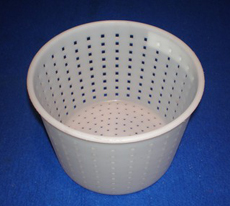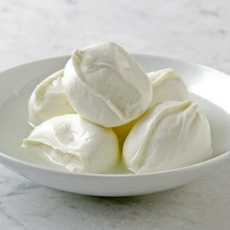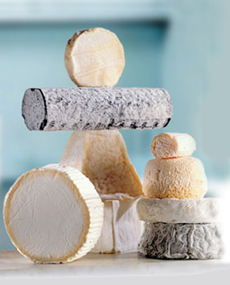
 Farmstead cow’s milk cheeses. Photo © Wisconsin Milk Marketing Board. Farmstead cow’s milk cheeses. Photo © Wisconsin Milk Marketing Board.
May 2005
Last Updated November 2025
|
 |
Types Of Cheese Glossary
Cheese Terms & Definitions Every Cheese Lover Should Know
Page 5: Cheese Terms Beginning With F & G
This is Page 5 of a 12-page glossary. Click on the letters below to find terms of interest. When you’re finished with cheese, visit our many other food glossaries.
Click on a letter to go to the appropriate glossary section.
a b c d e f g h i j k l m n o p q r s t u v w x y z
This glossary is protected by copyright and cannot be reproduced in whole or in part.
You are welcome to link to it.
FAISSELLE
A faisselle is a mold with holes used in cheesemaking. It allows the whey to drain out and the curds to be compacted. Faisselles come in dozens of different shapes and sizes.
|
|

Cheese mold or faisselle. Photo © Avedemil. |
FARMER CHEESE, FARMER’S
CHEESE or FARMERS’ CHEESE
A fresh (unaged), simple, cow’s milk cheese that’s the “child” of cottage cheese (see below), and a relative of paneer, queso blanco (more solid, like feta) and queso campesino (Spanish for farmer’s cheese, more like cottage cheese with curds). Here’s more about farmer’s cheese, including a recipe to make your own at home.
- Cottage cheese: The fresh, drained curds of slightly soured, pasteurized milk. The whey is drained from the curds, and the remaining curds are known as cottage cheese.
- Pot cheese: Drained longer, cottage cheese becomes a drier-curd product known as pot cheese.
- Farmer cheese: When the remaining moisture is pressed out of cottage cheese, causing it to become dry and crumbly, it is called farmer cheese.
|
|

Homemade farmer’s cheese. Photo © GoodEggs. Here’s the recipe. |
FARMSTEAD CHEESES or FARM CHEESE
|
A cheese that is made on the farm by the farmer, using only the milk from the farmer’s own herd or flock, on the farm where the animals are raised. Milk used in the production of farmstead cheeses may not be obtained from any outside source. As with artisan cheeses, farmstead cheeses may be made from any type of milk and may include various flavorings and inclusions. “Artisan” refers to the manner in which the cheese is made, using traditional techniques, and “farmstead” refers to the source of the milk and where the cheese is made.
|
|

Farmstead cheese maker Ginnie Tate of Goat Lady Dairy and two of her herd. |
A cheese can be both artisan and farmstead or can be one and not the other. For example, Point Reyes Farmstead Cheese Company makes its cheese from its own herd of dairy cows, Point Reyes Original Blue Cheese, so its cheese is both artisan and farmstead. Cowgirl Creamery makes artisan cheeses but buys the milk from the Straus Family Creamery, so the cheese is not farmstead. See also artisan cheese.
FAT CONTENT
This term refers to the fat content in the dry matter of the cheese. It is usually indicated on the cheese’s packaging. It can be as low as 4% and as high as 75%. The terms butterfat and milkfat are used interchangeably.
FETA CHEESE
|
Feta is Greece’s most famous cheese, a pure white, aged curd cheese that crumbles easily. Authentic feta is a sheep’s milk cheese or a mixture of sheep’s and goat’s milk. Outside of the EU, where it is protected, it can also be made of cow’s milk. It is formed into bricks, salted and cured in a brine solution. The cheese is semi-hard, with a flavor that can range from mild and milky to salty with a very tangy acidity. If too salty, it can be soaked in water or milk to remove some of the saltiness. While the cheese has been made since antiquity, the current name came into the Greek language in the 17th century from the Italian word fetta, slice, referring to slicing the cheese from the brick.
|
|

Feta cheese with olives. Serve it with a drizzle of olive oil and bread: a delicious mezze (appetizer) (photo © Aragec). |
Only 2% of the feta consumed in the U.S. actually comes from Greece. Much of it is saltier feta from Bulgaria and elsewhere. Authentic feta is aged in wood barrels for 60 days, creating a creamy, tangy cheese with citric notes.
FIOR DI LATTE MOZZARELLA
|
Mozzarella can be made of water buffalo milk or cow’s milk. The former is called mozzarella di bufala; the latter, fior di latte (flower of the milk). While “flower of the milk” may sound more appealing than “water buffalo milk,” water buffalo mozzarella is more flavorful and costly.
|
|

Freshly made mozzarella. Photo courtesy Cheesemaking.com. |
FIRM CHEESES or HARD CHEESES
|
Firm or hard cheeses are a broad group that are very mild to very sharp. Firm cheeses generally have a texture profile that is elastic, at room temperature, like Emmenthaler and Gruyère); some are more rigid, like Cheddar. Others, like Gouda, can be flexible to start, but age to a hard cheese that can be grated. Other hard cheeses are hard at the time of their release, such as Asiago, Grana Padano, Parmigiano-Reggiano (Parmesan), and Pecorino. Read about this group of Italian grating cheeses.
|
|

Parmigiano-Reggiano and Grana Padano are examples of hard cheeses. Photo courtesy iGourmet.com. |
FONTINA CHEESE
|
Fontina has been made in the Aosta Valley of the Italian Alps since the 12th century. The Consorzio’s stamp has an image of the Matterhorn. The cows that produce the milk for Fontina Val d’Aosta graze on high-altitude Alpine pastures dotted with wildflowers and native herbs. Authentic Italian Fontina has a natural rind, which is typically tan to orange-brown depending on the length of aging; it is fairly pungent with an intense flavor. Fontina is a great melting cheese as well as a popular table cheese; the name comes from the Italian “fondere,” to melt. Young fontina, made from unpasteurized cows’ milk aged 90 days, has a mild, somewhat nutty flavor, with herbaceous, grassy, and fruity notes. With a softer texture than mature Fontina, it is often used for fondue. Mature fontina is a hard cheese, aromatic and “stinky.”
Fontina production occurs in other parts of Italy, as well as Canada, Denmark, France, Sweden, and the United States. Derivative cheeses include Fontinella (Italy) and Fontal (Belgium) and are milder than the original. Fonduta alla valdostana is a traditional dish of fontina whipped with milk, eggs, and truffles.
|
|

Fontina, from the Italian Alps. Photo above © iGourmet. The photo below is a Fontina made in the U.S., in Wisconsin (photo © Emmi Roth).

|
FRESH CHEESES or SOFT, UNRIPENED CHEESES or FROMAGE FRAIS
|
A high-moisture-content, unaged cheese, intended to be eaten within days of its production. While the cheese has not been aged, some, like feta, may be very slightly cured. Fresh cheese is drained, coagulated milk (simple lactic set curd), or lightly renneted milk, served young and lightly salted, which does not undergo a ripening period. These cheeses have a creamy, soft texture and fresh, sweet flavor, although the pasteurized-milk cheeses of the U.S. are less flavorful than fresh cheeses made in other countries from unpasteurized milk (U.S. law requires all cheeses aged fewer than 60 days to be made of pasteurized milk to eliminate potentially harmful bacteria). The cheeses can be made from any type of milk. Uncomplicated in flavor, fresh cheeses are often used in cooking, for breakfast, or with fruit for dessert.
|
|

Queso fresco. Photo by Claire Freierman | THE NIBBLE. Read our review of Mexican and Latin American cheeses. |
Examples of fresh cheese include many goat cheeses, plus burrata, caciotta, cheese curds, cottage cheese, cream cheese, feta, fromage blanc, hoop cheese, mascarpone, mozzarella, ricotta, string cheese, quark, queso blanco, and queso fresco. Learn the terms for describing fresh cheeses.
FROMAGE
The French word for cheese.
FROMAGE BLANC
|
Fromage blanc is a cow’s milk cheese related to quark. It is totally fat-free and all protein. (Quark is not fat-free). Many people eat it for dessert, either plain or with sugar and/or fruit. Fromage blanc is also used in uncooked savory dishes. Since it has no butterfat, it will separate if cooked. While fromage blanc looks like yogurt (see photo at right), it is a proper cheese, beginning with rennet and a starter culture added to the milk. However, the curds are not allowed to coagulate as they would with traditional cheese. Instead, they are stirred to the consistency of yogurt. Some producers add cream to achieve more richness, which can produce a product with up to 8% fat. Read the label! Without the cream, it’s a caloric bargain, like non-fat plain yogurt.
|
|

Fromage blanc from Vermont Butter & Cheese Company. Photo by Claire Freierman | THE NIBBLE. Read our review. |
FROMAGER
The French word for cheesemonger or cheese expert.
FROMAGERIE
The French word for cheese store.
FRUITIÈRE
Specific to the French region of Savoie, the word is for a small cheese producer or cooperative that collects milk.
GEOTRICHUM CANDIDUM
Geotrichum candidum is a yeast-like fungus that’s widely used in the production of cheeses: on bloomy rind cheeses such as Brie and Camembert; on certain goat cheeses, where it creates a brain-like pattern; on washed rind cheeses such as Saint-Nectaire; and on Alpine cheeses such as Tomme de Savoie. It’s often characterized as an intermediate between molds and yeasts, but has been classified as a yeast for more than 25 years. or mold. Apart from a benefit to cheeses, it can cause sour rot on certain fruits and vegetables, including citrus, soybeans, strawberries, stone fruits (nectarines, peaches), sweet potatoes, and tomatoes.
|
|

Goat cheese with a brain-like pattern on the rind, caused by Geotrichum candidum. This beauty is Coupole from Vermont Creamery. Photo © Murray’s Cheese. |
GOAT CHEESE or GOAT’S MILK CHEESE or CHÈVRE
|
Chèvre is the French word for both goat and goat cheese. Goats were tamed around 10,000 B.C.E., and goat’s milk cheese began to be made in the Mediterranean. The Romans ate small goat’s cheeses soaked in olive oil, which were part of army rations. Goat cheese is known for both its fresh and aged varieties. Some cheeses are briefly aged (4 to 6 weeks), developing rinds and flavors that have length and complexity. Examples of goat cheeses are classic Loire styles such as Selles sur Cher, Ste. Maure, Chevrot, and new American classics like Humboldt Fog. Goat cheese is so white because goat’s milk contains no beta-carotene. Goats produce more milk by volume than sheep, but far less milk than the much larger cows. Milked twice a day, cows produce 8-20 quarts per day, goats produce 3-5 quarts of milk and sheep produce one quart of milk.
|
|
 An assortment of fresh and aged goat’s milk cheeses. Photo courtesy FrenchGoatsCheee.com. An assortment of fresh and aged goat’s milk cheeses. Photo courtesy FrenchGoatsCheee.com. |
As a result, many goat cheeses are small and delicate, such as the ones in the photo. In general, goat’s milk is tangy and herbaceous, flavors that are found in both fresh and aged cheeses. Goat’s milk has a reputation for having a “goaty” flavor and aroma, which puts off some people. However, this is the result of mishandled milk or an unclean milking parlor rather than an inherent flavor of goat’s milk. Goat’s milk has the lowest fat content (when compared to cow’s and sheep’s milk) and, along with water buffalo’s milk, is the easiest on the human digestive system. Also, see cow’s milk, sheep’s milk, and water buffalo’s milk.
GORGONZOLA
|
One of the world’s great blue cheeses, Gorgonzola, comes from the Lombardy region of Italy; the actual town is outside of Milan, although the neighboring town of Pasturo claims the cheese originated there. A stracchino-type cow’s milk cheese,* Gorgonzola dates to 879 C.E. The cheese was originally made without its famous blue-green veining and piquant flavor, which happened sometime in the 11th century and came from Penicillium gorgonzola mold spores that are injected into the cheese. Gorgonzola is made in two varieties: Mountain Gorgonzola, the sharper and firmer version, and Dolce (sweet) Gorgonzola, a spreadable and elegant version that lacks the sharpness of the Mountain Gorgonzola. Both types are wonderful desserts when served with a drizzle of honey.
____________
*Goat’s milk Gorgonzola is also made.
|
|

Mountain Gorgonzola, available at iGourmet.com. |
GOUDA
In the Middle Ages, the Van der Goude family built a castle on the bank of the Gouwe River. The settlement around the castle grew into the town of Gouda, which became known for its fine aged cheese, Goudse kaas (“Cheese from Gouda”) made from cow’s milk. The name is not origin-protected, so anyone can make Gouda (pronounced HOW-duh in Dutch). With an authentic Gouda, the longer the cheese ages, the harder and saltier it gets. Younger Goudas are creamier. Extra-aged and triple-aged Goudas (five years of aging) can be found. The longer the cheese is aged, the more intense and complex the flavors. Older Goudas deliver exciting butterscotch flavors that complement the pungency. Read our full article on Gouda to learn all about this wonderful cheese and see photos of younger Goudas.
|
|

A triple-aged Gouda, available at iGourmet.com. It doesn’t get better than this! |
GRUYÈRE
Gruyère is both the name of one of the best-known Swiss cheeses and a general name for large cheeses made in France, such as Beaufort, Emmentaler, and Gruyère de Comté. Swiss Gruyère is the original, named after the town of Gruyères in the canton of Fribourg, Switzerland.
In the U.S., attempts to trademark “Grueyère” were struck down in 2022 by a U.S. District Court, which ruled that the term “gruyere” is generic and cannot be protected with a certification mark. A Circuit Court of Appeals then upheld a U.S. Patent and Trademark Office (USPTO) ruling that “gruyere” can legally be used to describe cheese regardless of where it was made. The USPTO rejected a bid by two groups representing cheese producers from Switzerland and France for a mark that would restrict the use of “gruyere” to cheese from Gruyère itself.
> Here’s the history of Gruyère.
|
|

Gruyère (photo © Gruyère France | Facebook). |
The Difference Between Swiss Gruyère (Le Gruyère AOP) and French Gruyère (Gruyère IGP)

Also see:
Continue To Page 6: Terms Beginning With H To L
Return To The Article Index Above
Lifestyle Direct, Inc. All rights reserved. Some material copyright Murray’s Cheese. Images are the copyright of their respective owners.

|


















